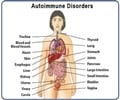Autoimmune diseases occur due to the misguided attack of immune system. Factors for chronic nature of autoimmune diseases is identified, reveals study.

‘Chronic nature of autoimmune diseases occur due to factors that include cell-signaling proteins called cytokines specifically interleukin-7 and -15 (IL-7 and IL-15)’





Th17 cells are a subset of T cells that are known to contribute to autoimmune disorders. The memory maintaining capacity of Th17 cells were not clear until now.The research findings were able to show that IL-7 and IL-15 signal the Th17 cells to chronically stay in the body and may help to address a variety of chronic autoimmune disorders.
The study findings were published online in the Journal of Autoimmunity.
"We wanted to know the precise factors that maintain memory in Th17 cells so that we can better understand what is causing chronic autoimmune disorders," said senior author Reza Dana, M.D., M.Sc., MPH, Director of the Cornea and Refractive Surgery Service at Mass. Eye and Ear and the Claes H. Dohlman Professor of Ophthalmology at Harvard Medical School. "By selectively targeting the production and expression of IL-7 and IL-15, we may be able to prevent the development of chronic autoimmune disorders."
Affecting up to 50 million Americans, autoimmune disorders develop when the body's immune system attacks its own healthy tissue. Many autoimmune disorders are chronic, and patients may experience "flare-ups," in which symptoms worsen temporarily and then enter a period of remission.
Advertisement
Using a mouse model for dry eye disease, an autoimmune condition affecting the surface of the eye, the study authors set out to determine what molecular factors are critical for the maintenance of Th17 memory. They identified IL-7 and -15 as playing a crucial role in the survival and homeostatic proliferation of memory Th17 cells, and when they neutralized IL-7 and IL-15, they saw a substantial reduction of memory Th17 cells.
Advertisement
"In the case of dry eye disease, many of the treatments are showing limited efficacy in patients that do not have a highly inflamed eye," said Dr. Dana. "Targeting the chronic, immune nature of autoimmune diseases may be a better strategy for controlling these conditions."
Source-Eurekalert














